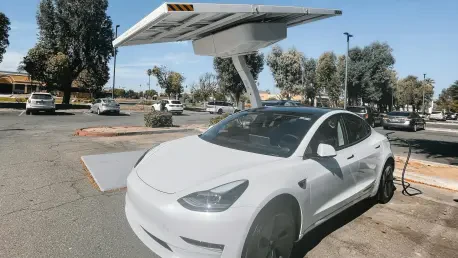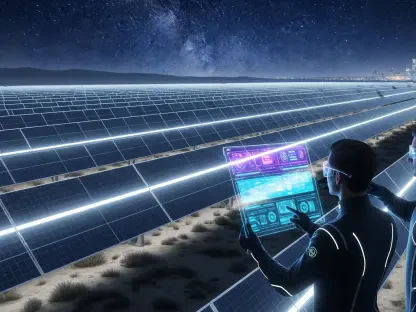As the world races toward a sustainable future, electric vehicles (EVs) stand at the forefront of reducing carbon emissions and transforming personal and commercial mobility into a cleaner, greener paradigm. The shift from traditional combustion engines to electric alternatives is no longer a distant dream but a pressing necessity, driven by the urgent need to combat climate change and meet global emissions targets. However, the widespread adoption of EVs hinges on a critical factor: the availability of robust and accessible charging infrastructure. Without a reliable network of charging stations, the transition risks stalling, leaving drivers stranded and skeptical. A major financial institution is stepping up to address this challenge head-on, channeling significant funds into the development of EV charging networks across key markets. This strategic focus not only supports environmental goals but also positions the bank as a pivotal player in shaping the future of transportation.
Accelerating EV Adoption through Strategic Financing
The journey to mass EV adoption is fraught with obstacles, chief among them being the lack of convenient and widespread charging options that can rival the ease of refueling traditional vehicles. Recognizing this gap, a leading financial institution has committed to financing innovative solutions that make charging infrastructure more accessible to the public. By prioritizing investments in this sector, the bank aims to eliminate one of the most significant barriers to EV uptake. A dedicated team within the organization, focused on accelerating the transition to sustainable technologies, has been tasked with creating financing models that mitigate risks while maximizing impact. These efforts reflect a broader understanding that scaling up low-carbon transportation requires bold steps, even when financial uncertainties loom large. The emphasis on public charging networks underscores a commitment to ensuring that EVs become a practical choice for all, regardless of location or economic background.
Beyond crafting innovative financial structures, the bank acknowledges that embracing risk is essential to achieving societal goals related to emissions reduction. This perspective is evident in the proactive approach to funding projects that might otherwise struggle to secure capital due to their early stage or market volatility. The focus extends to supporting infrastructure that can keep pace with the rapid growth in EV demand, ensuring that charging stations are not just available but also efficient and reliable. Partnerships with industry stakeholders further amplify these efforts, creating a collaborative ecosystem where environmental imperatives align with economic opportunities. By taking calculated risks, the institution is helping to build a foundation for EV success, paving the way for a future where sustainable mobility is the norm rather than the exception. This strategic vision highlights the critical role of financial backing in overcoming systemic challenges in the EV landscape.
Global Partnerships Fueling Charging Network Expansion
Concrete actions speak louder than promises, and the bank’s tangible contributions to EV infrastructure are evident through high-impact partnerships with leading providers across multiple continents. Significant financing has been directed toward a major European ultra-fast charging network, enabling the expansion of stations that facilitate seamless long-distance travel for EV drivers. Similarly, a green loan provided to a French company supports the rollout of ultra-fast charging hubs across nine European countries, enhancing accessibility in diverse regions. In the United States, commercial financing has been extended to a key player for high-power charging stalls in major metropolitan areas, addressing urban demand. These initiatives demonstrate a clear intent to make charging not only more widespread but also faster and more reliable, turning a potential inconvenience into a competitive advantage for EV adoption.
The impact of these partnerships extends beyond mere numbers, as they represent a dual opportunity for environmental progress and business growth. Experts within the bank emphasize that investing in charging infrastructure is both a necessity for sustainability and a promising commercial venture, given the accelerating pace of EV sales globally. By aligning financial support with market needs, the institution ensures that charging networks can scale efficiently, meeting the expectations of a growing user base. This approach also fosters confidence among consumers, who are more likely to transition to EVs when infrastructure concerns are addressed. Moreover, these collaborations highlight the importance of cross-border cooperation in tackling global challenges like climate change, showing how targeted investments can create ripple effects across regions. The synergy between financial strategy and technological advancement is proving to be a game-changer in the push for a low-carbon economy.
Aligning Financial Goals with a Sustainable Future
The broader mission of transitioning to a sustainable economy is deeply embedded in the bank’s strategic outlook, with EV infrastructure funding forming a critical pillar of this commitment. Aligning financing practices with net-zero ambitions, the institution supports clients and partners in their sustainability journeys, fostering inclusive solutions that engage diverse stakeholders. While a significant portion of the portfolio still ties to less sustainable sectors, there is a determined shift toward greener investments, reflecting the complex reality of transforming a major financial entity in tandem with societal needs. This nuanced balance illustrates a pragmatic yet progressive stance, prioritizing long-term environmental benefits over short-term gains. The focus on EV infrastructure is thus part of a larger tapestry of climate action, woven with threads of innovation and responsibility.
Looking back, the efforts to fund EV charging networks marked a defining moment in the bank’s journey toward sustainability. These initiatives not only supported the practical rollout of infrastructure but also set a precedent for how financial institutions could drive environmental progress. The partnerships forged and the risks embraced during this period laid crucial groundwork for a future where electric mobility became more accessible. Moving forward, the emphasis should remain on scaling these efforts, exploring new markets, and refining financing models to address emerging challenges. Stakeholders must continue to prioritize collaboration, ensuring that infrastructure keeps pace with EV adoption rates. Additionally, integrating advanced technologies into charging solutions could further enhance efficiency, solidifying the foundation for a cleaner transportation ecosystem. These steps, built on past achievements, offer a roadmap for sustained impact in the evolving landscape of sustainable mobility.









